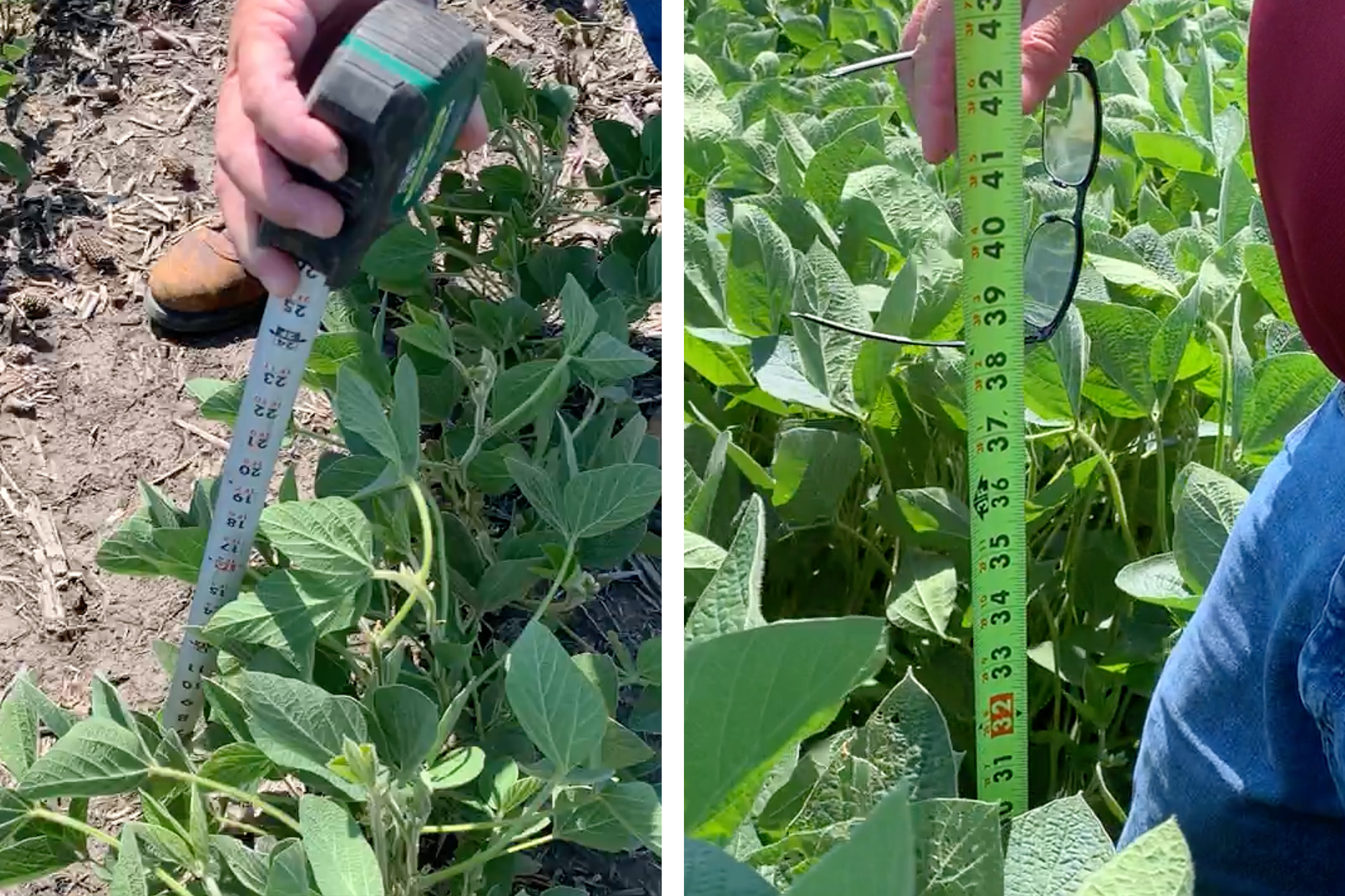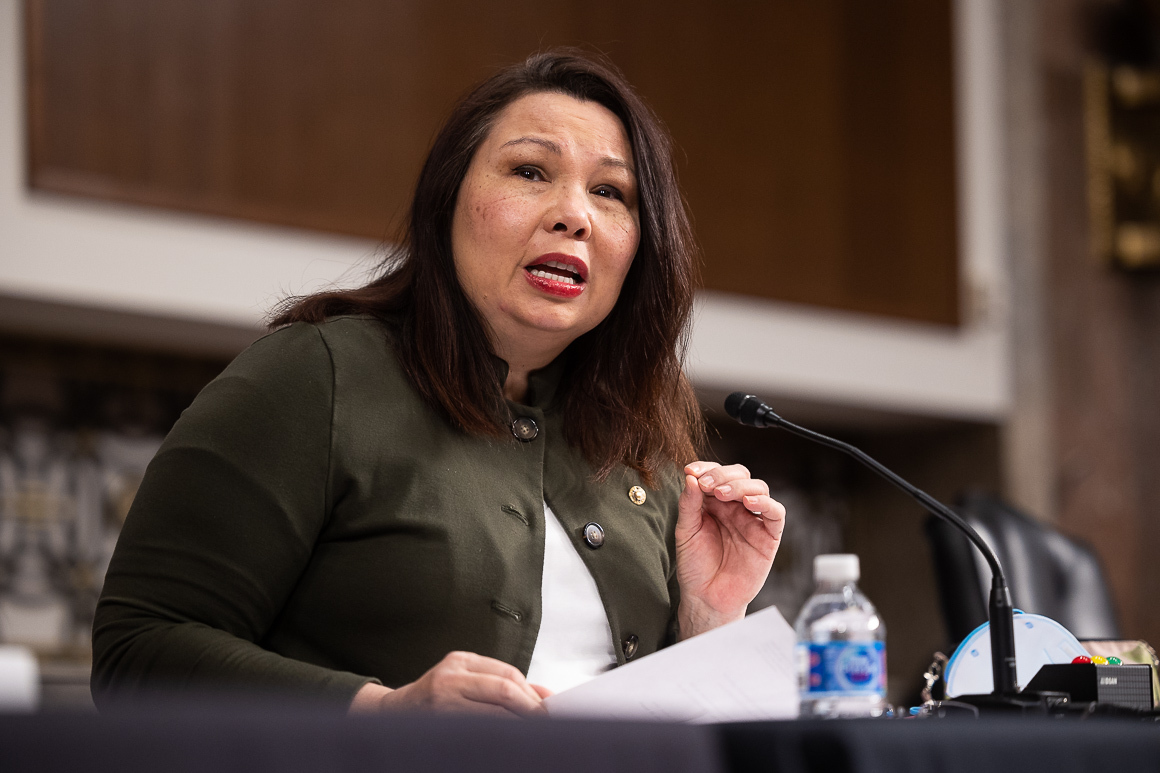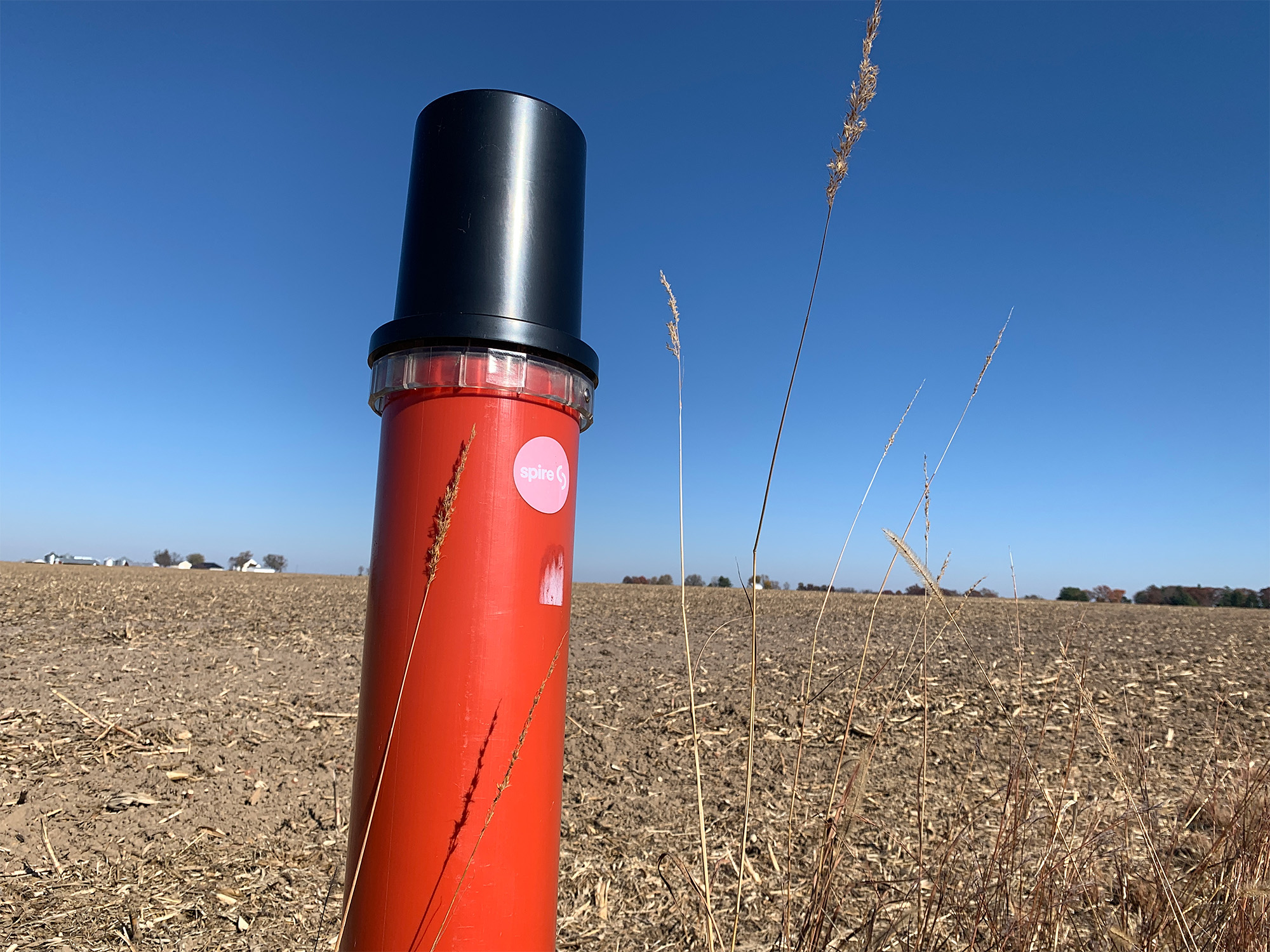FREMONT, Iowa — Steve Roquet’s soybean field was a sea of emerald as he waded in last summer under a bright, cloudless sky. The green leaves brushed his belt.
Then he got to the strip dug up seven years ago for the Dakota Access oil pipeline and looked down at pale plants and bare spots. Where the trench was cut, the plants reach only halfway up his calf.
That costs the fourth-generation Iowa farmer thousands of dollars per year.
“They told me within two to three years we’d be back to normal,” Roquet said. “In 500 years, it won’t be back to what it was.”
That’s why Roquet — pronounced “Rocky” — bitterly opposed another company’s plans to trench a second pipeline through his farm, this one to carry carbon dioxide instead of oil. But in late October, in the face of withering opposition and regulatory rejections, Navigator CO2 Ventures gave up on its plans to build the Heartland Greenway pipeline.
The collapse reflects the unpopularity of pipeline projects among some landowners in a region where resentment lingers from Dakota Access and other energy projects.
Complaints from landowners about safety and damage to their land have been a constant in the country’s pipeline fights. But they’ve typically taken a back seat to environmental groups’ concerns about climate change and companies’ promises of growth and jobs.
Now, red farm states are rejecting plans for new projects like Heartland Greenway. And the rejection of those plans could imperil a key element of President Joe Biden’s climate agenda: capturing carbon dioxide from industrial plants and piping it to facilities to be permanently buried. Other projects, like one billed by Summit Carbon Solutions as the biggest carbon project in the world, are pushing forward against vocal opposition.
Experts have said as many as 65,000 miles of carbon pipelines will be needed for the country to reach net-zero greenhouse gas emissions by 2050. And according to federal data, 6,000 miles of oil, gas and liquids pipelines are on the drawing board or under construction right now.
That comes on top of a building spree that saw more than 70,000 miles of oil and gas pipeline laid across the country since the end of 2010.
Pipeline construction is different from other industrial development in that it often takes place on other people’s land. To investigate how the build-out of oil and gas pipelines affected those in their path — and how CO2 pipelines could affect them in the future — E&E News reviewed thousands of pages of documents including lawsuits, academic studies, inspection reports and crop reports. E&E News also traveled to sites in Iowa, North Carolina, Oklahoma, Pennsylvania and Virginia to talk to landowners.
The company that built Dakota Access through Roquet’s land said it followed the rules and treated him fairly. But E&E News’ investigation found landowners have little recourse when pipeline companies break promises to restore their land to its original condition.
“It’s a process that needs to be fixed,” said Richard Glick, a Democrat who oversaw interstate natural gas pipelines when he chaired the Federal Energy Regulatory Commission. “I would not be happy with it if it was my land.”

Energy industry leaders say that while landowners’ complaints should be taken seriously, there are adequate protections and processes to handle problems. They say the opposition thwarting projects boils down to basic “not in my backyard” — or NIMBY — sentiments.
“This story appears focused on a very small percentage of landowners impacted by the buildout of critical energy infrastructure,” Amy Andryszak, CEO of the Interstate Natural Gas Association of America, said in response to questions from E&E News.
“There’s nothing new about NIMBY opposition to pipelines,” she said, “or, quite frankly, energy infrastructure generally.”
Yet companies proposing carbon pipelines in the Midwest say they realize they need to do better. The oil and gas industry also is looking at ways to better engage with landowners.
In Washington, the idea of loosening regulations to speed energy projects is a recurring theme. Congress exempted the Mountain Valley pipeline from regulatory requirements to get it built.
The White House did not respond to questions for this story. The Biden administration has backed the designation of energy corridors to help site carbon dioxide projects.
Some parties want FERC to get involved so pipeline developers would have the power of eminent domain to condemn land to lay carbon dioxide pipelines.
Still, Sen. Tammy Duckworth (D-Ill.) said lawmakers need to look at better enforcement and regulation, not less. A pipeline in her state has made her worry that fossil fuel projects may be poisoning the well for clean energy projects.
“The future of energy policy in this country — and a carbon-neutral future — is going to rely on pipelines,” Duckworth said in an interview. “So we have to do a better job of regulating them. Right now, it’s the wild, wild west.”
‘Not a damn thing you can do’

Spire, a St. Louis-based gas utility company that is the target of Duckworth’s scrutiny, was one of many businesses that launched a pipeline project amid the country’s oil and gas boom.
The company proposed a 65-mile project to carry gas from a cross-country natural gas pipeline south through rural Illinois and under the Mississippi River to St. Louis. In 2018, FERC gave final approval, conferring on the company the power of eminent domain.
Among the unwilling sellers were Rob Parker, who farms with his brother and father in Jersey County, Illinois, and Kenny Davis, a retired utility lineman and supervisor in Scott County, Illinois. Davis had hoped to build a home for his retirement in the middle of the wooded parcel Spire designated for the pipeline, a place where he could walk out his door and go hunting.
Spire, Davis said, had been willing to route the pipeline along the side of his property to allow for the house. But then, Davis told the Spire project manager he wouldn’t sign an easement. Furious, the manager warned him that Spire would get his property anyway, he said. Even more, the pipeline would go right through the middle of it.
“And there’s not a damn thing you can do about it,” Davis recalled the man saying.
Now, his property has a two-foot-wide, high-pressure gas line where the house was supposed to be. For others, the line runs as close as 200 feet from their front door.
Parker said things started going south on the first day of construction. Crews showed up unannounced at his cow pasture, cut big gaps in the fencing and started digging a trench for the pipeline.
Alerted by a neighbor, Parker had to leave the store where he works in the middle of the day to gather up his cattle. An $8,000 cow, separated from her calf, broke a leg trying to cross the ditch that had been cut, according to Parker, who eventually gave the cow to a neighbor.
After construction finished, debris left behind in one of Parker’s fields caused thousands of dollars in damage to a combine blade that hit it, he said. The corn from Davis’ small patch of cropland is stunted where the pipe crossed. And Davis recently discovered there’s a 300-foot-long road buried through his property made of treated lumber mats used in construction.

But as mad as Davis and Parker are at Spire, they’re even more angry at FERC. The agency, they say, didn’t do enough to prevent damage to their land and has done precious little to get Spire to fix it.
“It’s like they’re in cahoots,” Parker said.
As the farmers’ complaints piled up during construction, FERC defended Spire.
“Spire is appropriately documenting any environmental compliance issues,” FERC’s then-chair, Neil Chatterjee, wrote to local members of Congress in 2019, “and is properly resolving these issues.”
Attempts to reach Chatterjee, a Republican, for comment were unsuccessful.
FERC had one big chance, landowners say, to help them get their farms fixed. Agency officials could have forced Spire to finish restoration before it started up the pipeline. Not only were landowners complaining, but Illinois regulators were alleging Spire was polluting the water along the route. In November 2019, FERC gave the green light.
The “restoration is proceeding satisfactorily,” wrote Rich McGuire, director of the FERC division that handles pipeline projects.
More than four years later — long after it should be finished — the agency still says restoration is proceeding satisfactorily.
But allegations of violations keep coming from state agencies. Illinois Democratic Attorney General Kwame Raoul is seeking to hold Spire in contempt for failing to fix erosion problems. In July, the state Agriculture Department said restoration remains incomplete on 18 properties.
Spire officials, asked about Illinois’ allegations, point to a FERC report in August stating “nearly all of the land along the right of way is restored.”
Company spokesperson Jason Merrill declined to respond to the specific accusations leveled by landowners like Davis and Parker, but he said the company wants restoration issues to be resolved just as much as landowners do.
“We are proud of the work we’ve done to treat landowners well,” Merrill said in a statement to E&E News. He said 179 landowners have reached agreements with the company, “and we feel they would tell you we’ve been a good partner.”
Duckworth, though, would not say that. The senator called Spire’s treatment of the landowners “unacceptable.” In October, Illinois Democratic Gov. J.B. Pritzker joined Duckworth in pushing FERC to speed restoration.
“If it’s happening in Illinois with this pipeline,” Duckworth told E&E News, “I’m sure it’s happening in other places across the country.”
Indeed, landowners all over the country say regulators lack the will or the power to protect them.
In Virginia, farmers say their land was overrun by mud when heavy rains scoured a Mountain Valley natural gas pipeline construction site. During construction of a gas transmission line in Ohio, farmers say crews flooded their cropland with water pumped out of pipeline ditches. In Oklahoma, a farmer said a gas pipeline crew stole a truckload of his topsoil without explanation.
Glick, the former FERC chair, said most pipeline companies do a good job. But FERC’s process for dealing with companies that fail to meet their responsibilities voluntarily, he said, is cumbersome —and the agency’s powers to penalize them are limited. He said he tried to change the culture during his tenure on the commission, but he said the staff is motivated to get permits out the door and keep energy projects moving, rather than protect landowners.
“They just don’t see that as their job, really,” he said. “It’s just not something they’ve been very aggressive on in the past.”
FERC staff declined to respond directly to the comments made by Glick and Duckworth. But agency officials told a congressional subcommittee they make sure landowners’ farms are fully restored.
‘There’s a lot of positives’

For farmers like Roquet, it all comes down to topsoil — the dark, rich, spongy layer that gives plants life.
Underneath that is yellowish, clumpy clay, far less fertile and less valuable. When pipeline crews dig a ditch to lay pipe, particularly when it’s wet, that precious topsoil can get mixed in with the clay. The equipment smooshes down the soil so seeds don’t take root as easily and rain can’t soak in.
Roquet’s topsoil, black in color, rich and two feet deep, is the envy of other Iowa farmers. He said that when the pipeline builders showed up on his land, he watched the crew move heavy equipment onto soaked ground, mixing the precious topsoil with clumpy clay.
Workers are supposed to scrape the topsoil off first, store it separately, then put it back on top when they’re finished. Many landowners have complained that crews failed to do that. And a study last year by researchers at Ohio State University found separating topsoil either doesn’t help or pipeline crews aren’t even doing it.
“Likely,” the researchers wrote, “a combination of these factors has driven our findings.”
When Roquet complained, he returned one night to find the crew had dumped his topsoil into the trench, to be buried under the yellowish clay subsoil. To Roquet, it seemed spiteful.
“A two-year-old would know the difference,” he said, shaking his head.
The topsoil was removed and placed on top after Roquet complained again.
When inspectors tried to step in, they were ignored. A Dakota Access construction manager told the frustrated inspectors Roquet was being “unreasonable” and informed them that “Dakota Access is prepared to use its legal authority,” according to an inspector’s written report. The next day, crews took down the protective fencing inspectors fashioned to keep them out, then resumed construction.
After that, those same inspectors prepared an inch-thick binder documenting three violations for working in wet conditions, mixing topsoil and flooding a field with water drained from the trench. But the inspectors rescinded their allegations after attorneys for Energy Transfer wrote to them, asserting Roquet’s topsoil wasn’t as deep as Roquet says it is.

Some landowners have had more positive experiences.
Kelly Nieuwenhuis, a farmer in western Iowa and chair of the Iowa Corn Promotion Board, said his family was happy with what Dakota Access developers paid for access and crop losses.
The fields crossed by Dakota Access, he said, are back to producing just as well as the untouched land on either side of them. Plus, the project delivered jobs and is bringing in tax dollars for farm counties. Nieuwenhuis’ family farm business signed agreements allowing both the Summit and Heartland Greenway pipelines to cross their land.
“There’s a lot of positives nobody ever mentions,” Nieuwenhuis said.
And he doesn’t understand how corn farmers could oppose a project he sees as vital to the future of corn-based ethanol as a fuel additive.
“I never in my wildest dreams thought people would fight something that would benefit them,” Nieuwenhuis said.
Midwestern pipelines are a crucial part of plans to capture and liquefy carbon dioxide from the production of ethanol, then pipe it to sites where it can be pumped underground for permanent disposal.
Backers say the worldwide push for lower-carbon fuels could jeopardize ethanol, and with it, the Midwestern farm economy. Chris Boshart, chief executive of a farm co-op and ethanol production facility, said the pipelines are vital to some of the same farmers who are fighting them.
“If your local ethanol plant doesn’t have a chance to capture carbon,” he said in an interview, “then the future could be challenging.”

Pipeline companies generally pay for three to five years of damage to crops in the pipeline’s path. They pay 100 percent for the first year, when they’re digging through fields. After that, they pay a diminishing amount, 50 or 60 percent in years three and four, then zero.
Energy Transfer, the Dallas-based company behind Dakota Access, paid more than that in many places, according to company spokesperson Vicki Granado. She said farmers were paid up front for three to five years of crop losses, in some cases at 100 percent for all years.
Dakota Access “is in fact keeping landowners whole,” Granado said. “Only in isolated circumstances do farmers continue to experience a yield reduction compared to pre-construction production.”
That would more than cover crop losses documented by an Iowa State University study funded by Energy Transfer. The study found crop yields within the easements dropped were reduced by an average of 25 percent for soybeans and 15 percent for corn during the first and second crop seasons, compared to undisturbed fields.
Roquet said the damage to his cropland has lasted well past the five-year horizon. And there are plenty of other examples of persistent losses.
In a 1988 study, researchers found Canadian farms still suffered crop losses of more than 25 percent a decade after the installation of an oil pipeline.
Farmers along the Alliance pipeline, which delivers natural gas from Canada to Chicago across the High Plains, said crop losses continued for 14 years after it was installed in 2000. But they stopped receiving payments in 2015. The landowners sued, and the case is still pending.
In response to questions about the dispute, Alliance operator Enbridge said in a statement that “Alliance works with thousands of landowners along its right-of-way, and it will continue to do so.”
An Ohio State study published earlier this year found crop damage persisted five years after construction finished in Ohio.
The study looked at 29 sites across eight Ohio counties where three pipelines were built. In 2021, five years after construction ended, researchers found that corn yields were down by nearly 20 percent. Corn yields decreased at more than 70 percent of the farms surveyed.
Summit, the company planning the largest of the Midwestern carbon dioxide projects, is offering farmers terms similar to what Dakota Access offered.
The company is telling farmers it will pay — upfront — 240 percent of the value of the crop that will be affected by construction of the 2,000-mile pipeline system. That is meant to cover 100 percent of crop loss the first year, 80 percent the second year and 60 percent the third year.
Lee Blank, the chief executive of Ames, Iowa-based Summit Carbon Solutions, said his company is fundamentally different from the pipeline companies that have gone before it. That’s because, he said, it’s an agriculture firm and not an oil company.
“My mission and goal for the company is to return the acre to how it was before,” Blank said in an interview last summer.
NIMBY issues

Industry leaders warn that landowners’ hostility to pipelines threatens to slow down the transition to cleaner energy if regulators agree with the NIMBY approach. And that, they say, could hinder efforts to reduce the effects of climate change.
“The energy transition isn’t going to happen without CO2 pipelines, period,” said John Stoody, a vice president with the Liquid Energy Pipeline Association, an industry group that adopted its current name in 2022 to reflect new priorities in the industry such as carbon capture. “But if everyone wants to say no, or not in my backyard, then we’ll never get to the future we all need and want.”
Others talk openly about a need for change when it comes to interactions with landowners.
“We acknowledge that there’s room for improvement in that area,” Dave Murk, who is in charge of pipeline policy at the American Petroleum Institute (API), told E&E News.
After all, Murk said, pipeline companies and landowners are in a relationship likely to last decades. He’d like to make that relationship more neighborly, saying he’s hoping better communication can help.
API, the industry’s main trade group, has been working with the advocacy group Pipeline Safety Trust and others to develop new guidelines for pipeline operators to work with landowners and other members of the public. The concept is known as community engagement.
Still in the drafting stage, the effort is intended to push companies to communicate more with landowners and share more information, such as inspection reports and emergency response plans. The community engagement guidelines — called “recommended practices” — would be voluntary, but its standards carry significant weight in the industry.
And the Department of Transportation’s Pipeline and Hazardous Materials Safety Administration may incorporate them into federal pipeline safety rules, which would give them the force of regulations.
“If there’s an issue, it’s then on the landowner to reach back out to the operator,” said API’s Murk. “And our goal is to have a process in place that makes that easier for the landowner.”

